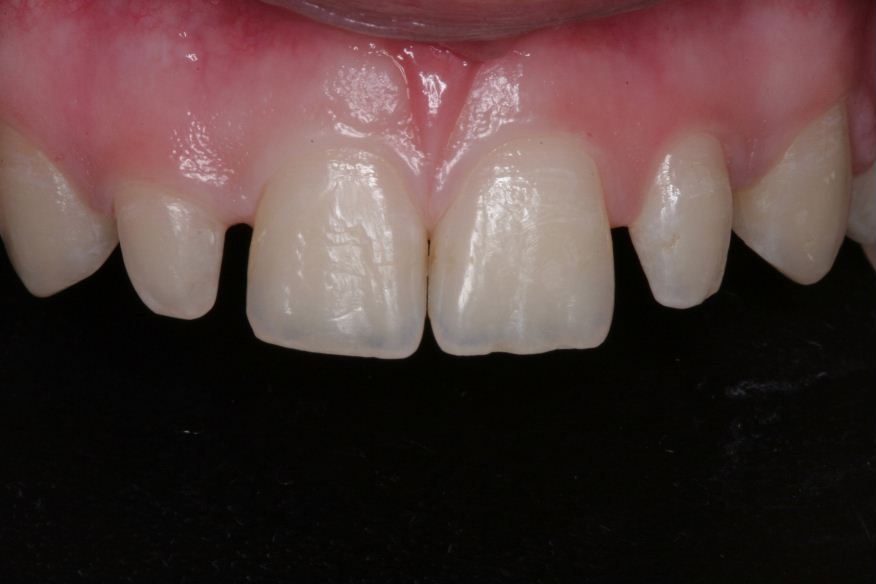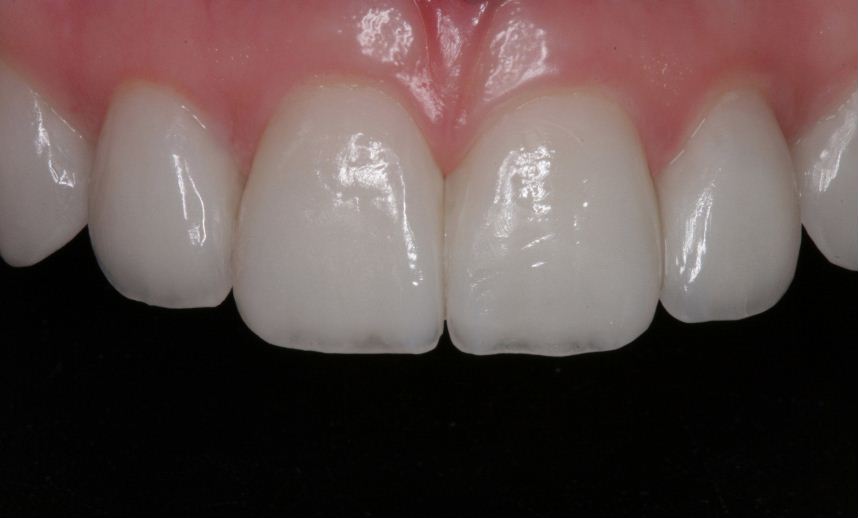Porcelain Veneers
Porcelain veneers offer a permanent solution to minor aesthetic discrepancies, such as spaces or gaps in the front teeth. Porcelain veneers are fabricated by preparing the tooth to allow a thin shell of porcelain to be bonded to the front of your tooth.
What are porcelain veneers?
Porcelain veneers, alternatively termed “dental veneers” or “dental porcelain laminates”, are wafer-thin shells of porcelain that are bonded onto the front side of teeth so to create a cosmetic improvement for a tooth. Porcelain veneers are routinely used by dentists as a way to make cosmetic changes for teeth that are discolored, worn, chipped, or misaligned.
What is the dental science associated with porcelain veneers?
Porcelain veneer technique is an offshoot of the basic science of cosmetic dental bonding. Dentists have had materials available to them for decades that are capable of creating a tenacious bond with tooth enamel. Porcelain veneer technique utilizes the bonding capability of these materials to securely attach a thin shell of porcelain (the porcelain veneer) to a tooth. Although porcelain is inherently brittle, when it is firmly bonded to a sturdy substructure (a tooth) it becomes very strong and durable.
What are some of the advantages of porcelain veneers over other types of cosmetic dental bonding procedures?
Porcelain veneers create a very life-like tooth appearance
You might be surprised to learn that while a large portion of every tooth is composed of dental enamel, teeth are not solid enamel. The enamel component of a tooth is actually just an outer encasement. The hard tooth tissue that lies underneath a tooth’s enamel layer is termed “dentin.”
Tooth enamel is translucent. One property of tooth enamel is that it’s translucent. This means that when light strikes a tooth’s surface it is not immediately reflected off, but instead penetrates into its enamel layer. Once the light has passed through the full thickness of the enamel it reflects off the opaque (non-translucent) tooth dentin that lies underneath, and then on back out of the tooth. This manner of handling light, the translucency effect of a tooth’s enamel, is an important aspect of what give teeth their characteristic lustrous appearance.
In the past the only cosmetic dental bonding materials that dentists had available to them were just semi-translucent. This meant that most of the light that struck a repaired tooth would not penetrate into the bonding but instead be reflected off its outer surface. The net result was that while the bonding did give the tooth an improved appearance, there was no sense of translucency (luster).
Porcelain veneers are translucent. Since porcelain veneers are glass-like in nature (ceramic) they have a great advantage over other cosmetic bonding techniques by way of the fact that they are translucent. When a porcelain veneer is bonded onto a tooth’s surface it will closely mimic the light handling characteristics of dental enamel.
When light strikes the surface of a veneered tooth it can penetrate on into the veneer’s porcelain, just like it does with dental enamel. Once it has traversed the full thickness of the porcelain the light will reflect off the opaque cement and tooth dentin that lies underneath the veneer, and then on back out of the tooth. This translucency effect of the porcelain creates a lustrous appearance for the tooth that very closely resembles the appearance of enamel.
Porcelain veneers resist staining
As a group, cosmetic dental bonding materials have the shortcoming of being susceptible to staining and discoloring. This is especially true when they are used in conjunction with individuals whose consumption habits include the use of tea, coffee, red wine, and tobacco products.
A significant advantage of placing porcelain veneers as opposed to cosmetic dental bonding is that a porcelain veneer’s surface is just that, porcelain. Since porcelain is a ceramic, and therefore glass-like, a veneer’s porcelain surface will be extremely stain resistant.


Veneers Before & After
Frequently Asked Questions
What are porcelain veneers?
Porcelain Veneers are thin shells of porcelain that are fabricated in a dental laboratory. They are bonded onto the front side, or facial surface of teeth to create a cosmetic improvement resulting in a gorgeous, natural looking smile.
Porcelain veneers can be used to correct crowded and misaligned teeth, discoloured teeth, teeth that are too long or too short, gaps between teeth and virtually any other cosmetic problems associated with teeth. The original teeth are shaped by the dentist to accommodate the placement of the veneers. Temporary veneers, which look gorgeous, are worn by the patient for a few weeks while the real veneers are being made at the lab.
Porcelain Veneers rarely stain, chip, break or come off. They are very strong and should last many, many years, and possibly forever. They feel natural in the mouth. Normally, only a few visits are needed to create a beautiful smile with porcelain veneers.
Are porcelain veneers an alternative to braces?
Depending on the age of the patient, porcelain veneers can be used to create a straight, white smile. Sometimes braces, or orthodontics, would be a preferable choice of treatment. A dentist can help you decide which option is better. Porcelain veneers normally can be done in a much quicker time frame than orthodontics. Veneers usually take a few weeks, while braces are usually worn for several years. Orthodontics can only change the alignment of teeth. Porcelain veneers can change alignment, as well as the shape and color of the teeth, creating a dazzling smile.
Once porcelain veneers are placed, are there any restrictions on the patient?
Patients who receive porcelain veneers are told to live their lives normally. They are told to care for their new smile with good oral hygiene and regular recall visits at the dental office to keep the teeth and gums healthy. That is the best way to keep the veneers in great shape. Basically, there are no restrictions once the veneers are placed. Common sense will help veneers to stay on forever.
What is the cost of porcelain veneers?
Porcelain veneers can be somewhat expensive, but patients who have had the procedure feel it was worth the cost. Having a gorgeous smile greatly improves one’s confidence and self-esteem. Each case is different, and the cost will vary with the complexity of the case.
Will dental insurance help pay for porcelain veneers?
Porcelain Veneers are normally considered a cosmetic procedure and therefore are not covered by dental insurance.
The price of veneers varies greatly from one dental office to the next. How can I choose where to go?
It is the clinical skills and experience of the dentist, along with the quality of the laboratory used to fabricate the veneers, which determines how the case will turn out. The Porcelain Veneer procedure is very technique sensitive.
Patients interested in having their smile enhanced with Porcelain Veneers should ask to see examples of the dentist’s work. Most good cosmetic dentists will have before and after photos of their cases to show to new cosmetic patients.
The confidence of the dentist and the staff is key. Some dentists will also have testimonials from some of their veneer patients. In summary, experience, skill level, confidence and choice of laboratory are the main factors that will help the cosmetic patient choose the correct dental office.
Will much of my teeth have to be ground down?
Some advertising creates the false impression that placing porcelain veneers requires that your teeth be “ground down”. It would be more accurate to say that your teeth are shaved a little. The amount of reduction is minimal and doesn’t damage the teeth.
Veneers are very thin similar to the thickness of a fingernail.
Book Your Consultation Today! No Referal Needed
To contact our prosthodontist about new or existing implants, fill out the form below. You can also reach us by phone at (519) 258-6722 or by email at info@wsdg.ca


